You searched for: 喀麥隆youtube推广【TG飞机:@bapingseo】YouTube竞价广告投放【TG电报:@bapingseo】西亚支付通道【Telegram:@bapingseo】捕鱼电玩城千炮版官网飞艇4码倍投方案集结号安卓版手机版官网下载?8hTtUx/692608.html
<< Previous | Displaying results 101-125 of 473 for "喀麥隆youtube推广【TG飞机:@bapingseo】YouTube竞价广告投放【TG电报:@bapingseo】西亚支付通道【Telegram:@bapingseo】捕鱼电玩城千炮版官网飞艇4码倍投方案集结号安卓版手机版官网下载?8hTtUx/692608.html" | Next >>
-
Nazi Camp System
SeriesLearn about the history of the Nazi camp system, the different types of camps, who was imprisoned and why, and conditions in the camps.
-
Fort Ontario refugee shelter
PhotoAmerican military police admit a father and daughter, both displaced persons, to the refugee shelter at Fort Ontario. Oswego, New York, United States, after August 4, 1944.

-
A survivor in Wöbbelin
PhotoA survivor in Wöbbelin. The soldier in the foreground of the photograph wears the insignia of the 8th Infantry Division. Along with the 82nd Airborne Division, on May 2, 1945, the 8th Infantry Division encountered the Wöbbelin camp. Germany, May 4-5, 1945.
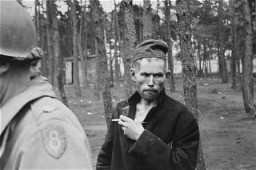
-
View of the Wöbbelin concentration camp
PhotoOn May 2, 1945, the 8th Infantry Division and the 82nd Airborne Division encountered the Wöbbelin concentration camp. Here, American soldiers patrol the perimeter of the camp. Germany, May 4-May 10, 1945.

-
US troops at the Wöbbelin camp
PhotoOn May 2, 1945, the 8th Infantry Division and the 82nd Airborne Division encountered the Wöbbelin concentration camp. This photograph shows US troops in the Wöbbelin camp. Germany, May 4–6, 1945.
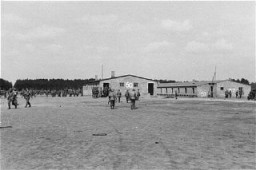
-
A chaplain with the 82nd Airborne Division helps a survivor
PhotoA chaplain with the 82nd Airborne Division helps a survivor board a truck that will evacuate him from the Wöbbelin concentration camp to an American field hospital. Germany, May 4, 1945.
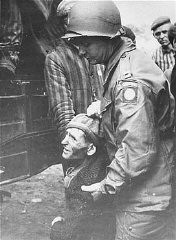
-
Bodies of prisoners discovered in Wöbbelin
PhotoA US Army soldier views the bodies of prisoners piled on top of one another in the doorway of a barracks in Wöbbelin. Germany, May 4–5, 1945.
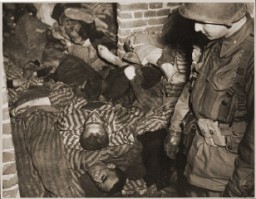
-
Father Charles Coughlin
PhotoFather Charles Coughlin, leader of the antisemitic Christian Front, delivers a radio broadcast. United States, February 4, 1940.
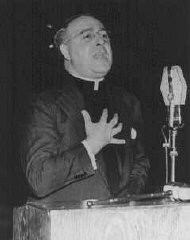
-
Caring for survivors of Wöbbelin
PhotoSurvivors of the Wöbbelin camp wait for evacuation to an American field hospital where they will receive medical attention. Germany, May 4-6, 1945.

-
Abba Kovner testifies during the Eichmann trial
PhotoJewish partisan and poet Abba Kovner, a survivor of the Vilna ghetto, testifies during Adolf Eichmann's trial. Jerusalem, Israel, May 4, 1961.
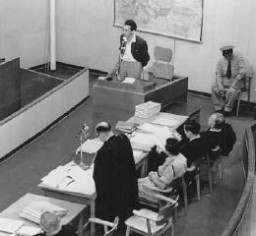
-
Social Democratic political prisoners in the Duerrgoy camp
PhotoSocial Democratic political prisoners in the Duerrgoy concentration camp near Breslau. Seated in the center is Paul Loebe, a leading Socialist and former president of the German parliament. Duerrgoy camp, Germany, August 4, 1933.
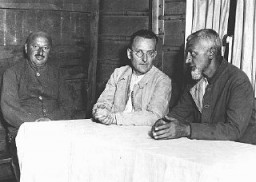
-
Abba Kovner testifies for the prosecution during the trial of Adolf Eichmann
PhotoFormer Jewish partisan leader Abba Kovner testifies for the prosecution during the trial of Adolf Eichmann. May 4, 1961.
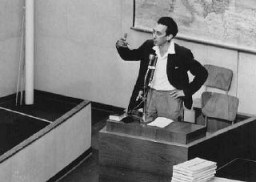
-
Burial of victims of the Kielce pogrom
PhotoMourners crowd around a narrow trench as coffins of pogrom victims are placed in a common grave, following a mass burial service. Kielce, Poland, after July 4, 1946.
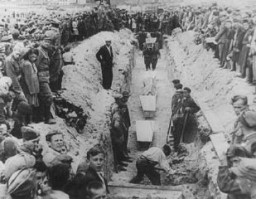
-
Lublin/Majdanek Concentration Camp: Areas of Research
ArticleLearn about areas of research related to the number of deaths at the Lublin/Majdanek concentration camp system.
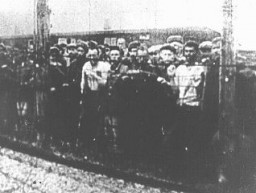
-
1946–1948: Key Dates
ArticleExplore a timeline of key events during 1946-1948. Learn about the aftermath of the Holocaust and the obstacles survivors faced.
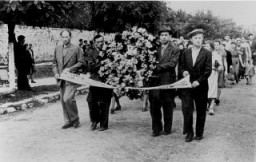
-
Members of the US press view rows of corpses
PhotoVisiting American newspaper and magazine correspondents view rows of corpses in Dachau. Photograph during an inspection following the liberation of the camp. Dachau, Germany, May 4, 1945.
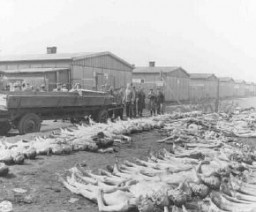
-
Baldur von Schirach at the Reich Academy for Youth Leadership
PhotoHitler Youth leader Baldur von Schirach speaking at the opening of the Reich Academy for Youth Leadership. Braunschweig, Germany, June 4, 1938.

-
British Troops Prepare for the Allied Invasion of Normandy
PhotoCaptain Lasdun briefs troops of the British Army on June 4, 1944, two days before the Allied invasion of Normandy on D-Day.
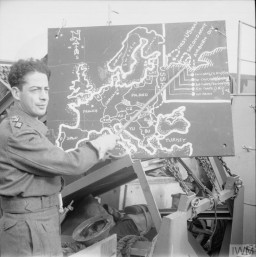
-
Judge Benjamin Barr Lindsey
PhotoAmerican judge Benjamin Barr Lindsey and his wife on a ship. Judge Lindsey's writings were among the texts the Nazis singled out during the 1933 public burnings of books. Photo dated December 4, 1915.

-
Mendel Rozenblit
ID CardMendel was one of six children born to a religious Jewish family. When Mendel was in his early 20s, he married and moved with his wife to her hometown of Wolomin, near Warsaw. One week after the Rozenblits' son, Avraham, was born, Mendel's wife died. Distraught after the death of his young wife and left to care for a baby, Mendel married his sister-in-law Perele. 1933-39: In Wolomin Mendel ran a lumber yard. In 1935 the Rozenblits had a daughter, Tovah. When Avraham and Tovah were school age, they began…

-
Helene Gotthold
ID CardHelene lived in Herne and Bochum in western Germany, where she was married to a coal miner who was unemployed between 1927 and 1938. Following their disillusionment with the Lutheran Church during World War I, Helene, who was a nurse, and her husband became Jehovah's Witnesses in 1926. Together, they raised their two children according to the teachings of the Scripture. 1933-39: Under the Nazis, Jehovah's Witnesses were persecuted for their missionary work and because they believed their sole allegiance…

-
Zelda Piekarska
ID CardZelda was born to a close-knit Jewish family in Sosnowiec, a city in the coal-mining region of Poland. Her father owned a restaurant and also co-owned a chocolate and candy factory. Zelda loved to dance; she was an excellent tap dancer. 1933-39: On September 4, 1939, the Germans entered Sosnowiec. Zelda's family was at her father's store when the German tanks rolled down the street. She saw people lying on the ground but didn't understand why. Her mother told her they were dead. Later, the Germans forced…
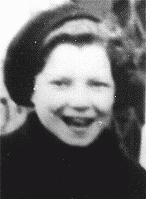
-
Janina Prot
ID CardJanina's parents had converted from Judaism to Catholicism in the 1920s. When Janina was 4 years old, her parents divorced; Janina left Warsaw and went to live with her father near the Polish town of Radom, while her brother Tomas remained in Warsaw with his mother. Janina, or Jana as she was affectionately known, loved to read. 1933-39: When Jana was 12 she moved back to Warsaw to attend secondary school, and stayed with her mother. A year later, on September 8, 1939, the Germans were bombing Warsaw.…

-
Maria Terez Halpert Katz
ID CardAlso known by her Yiddish name, Tobe, Terez was raised in a religious Jewish family. Her father and two brothers were rabbis. Though Terez was a promising student, she didn't pursue an advanced education because her traditional family wanted her to marry. So Terez married Menyhert Katz and moved to the town of Kisvarda [in Hungary]. There, she raised five daughters and one son; two other sons died. 1933-39: Terez's twin sons died when they were 8 months old, and she was convinced that their death was a…

-
Atrocities against Burma's Rohingya Population
ArticleThe Burmese military has targeted the Rohingya people because of their ethnic and religious identity. The military’s actions constitute genocide and crimes against humanity. Learn more

